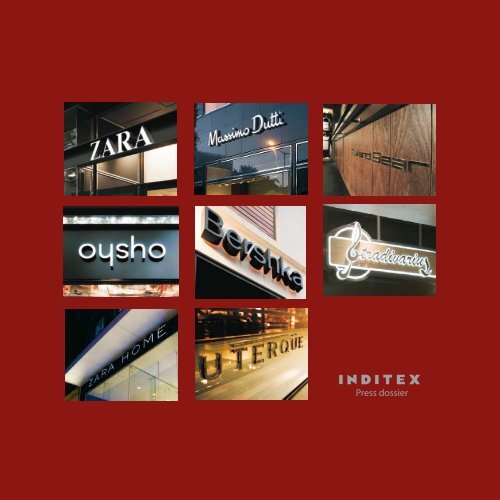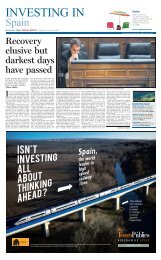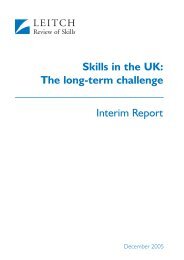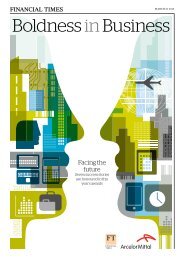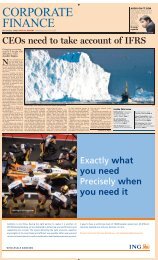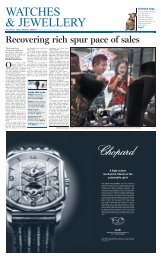Press dossier - Financial Times
Press dossier - Financial Times
Press dossier - Financial Times
Create successful ePaper yourself
Turn your PDF publications into a flip-book with our unique Google optimized e-Paper software.
<strong>Press</strong> <strong>dossier</strong>
<strong>Press</strong> <strong>dossier</strong>
the Group
Inditex, one of the world’s largest fashion<br />
distributors, has more than 4,280 stores in 73<br />
countries in Europe, the Americas, Asia and<br />
Africa. In addition to Zara, the largest of its<br />
retail chains, Inditex has other commercial<br />
formats: Pull and Bear, Massimo Dutti,<br />
Bershka, Stradivarius, Oysho, Zara Home<br />
and Uterqüe. The Group also includes more<br />
than a hundred companies associated with<br />
the different activities in the business of<br />
textile and fashion design, manufacture and<br />
distribution.<br />
Its unique management model, based on<br />
innovation and flexibility, and its vision<br />
of fashion (creativity and quality design,<br />
together with a rapid response to market<br />
demands) has resulted in fast international<br />
expansion and an excellent performance of<br />
its commercial formats.<br />
The first Zara store opened to the public in<br />
1975 in A Coruña (North-Western Spain), the<br />
place where the Group started business and<br />
where it has its central offices. Today, Inditex<br />
Group stores can be found in all the world’s<br />
major cities, always in the main shopping<br />
districts.<br />
ZARA KIDDY´S CLASS/SKHUABAN PULL AND BEAR MASSIMO DUTTI BERSHKA<br />
STRADIVARIUS OYSHO<br />
ZARA HOME<br />
5
6 INDITEx<br />
Ejercicio<br />
Turnover*<br />
Net Profit*<br />
Number of stores<br />
Number of countries<br />
International sales<br />
Employees<br />
Inditex has been listed on the Spanish Stock Exchange<br />
since 23 May 2001, after an IPO that aroused a great<br />
deal of interest among investors worldwide, with<br />
its shares being oversubscribed some 26 times<br />
over. Its shares are quoted on the main Spanish and<br />
international share indexes.<br />
Inditex has grown dramatically in recent years,<br />
achieving a consolidated turnover in 2008 of 10,407<br />
million euros, with a net profit of 1,253 million<br />
euros. On 31st January 2009 the Group had 89,112<br />
employees. The following table shows the Group’s<br />
most significant figures in 2008 and 2007:<br />
2008<br />
10.407<br />
1.253<br />
4.264<br />
73<br />
66%<br />
89.112<br />
2007<br />
9.435<br />
1.250<br />
3.691<br />
The Inditex financial year is from 1st February to 31 January of the following year<br />
* in millions of euros<br />
68<br />
62,5%<br />
79.517<br />
10%<br />
08/07<br />
-<br />
573<br />
5<br />
-<br />
9.595
The business model<br />
The Inditex business model is<br />
characterised by a high degree of<br />
vertical integration compared to<br />
other models developed by our<br />
international competitors. It covers all<br />
phases of the fashion process: design,<br />
manufacture, logistics and distribution<br />
to its own managed stores. It has<br />
a flexible structure and a strong<br />
customer focus in all its business areas.<br />
The key element in the organisation<br />
is the store, a carefully designed<br />
space conceived to make customers<br />
comfortable as they discover fashion<br />
concepts. It is also where we obtain<br />
the information required to adapt the<br />
offer to meet customer demands.<br />
The key to this model is the ability to<br />
adapt the offer to customer desires<br />
in the shortest time possible. For<br />
Inditex, time is the main factor to<br />
be considered, above and beyond<br />
production costs. Vertical integration<br />
enables us to shorten turnaround<br />
times and achieve greater flexibility,<br />
reducing stock to a minimum and<br />
diminishing fashion risk to the<br />
greatest possible extent.<br />
ZARA KIDDY´S CLASS/SKHUABAN PULL AND BEAR MASSIMO DUTTI BERSHKA<br />
STRADIVARIUS OYSHO<br />
MANUFACTURE DISTRIBUTION<br />
DESIGN SALES<br />
ZARA HOME<br />
7
8<br />
Design<br />
The business model<br />
The success of Inditex’s collections<br />
lies in the ability to recognise and<br />
assimilate the continuous changes<br />
in fashion, constantly designing new<br />
models that respond to customer<br />
desires. Inditex uses its flexible<br />
business model to adapt to changes<br />
occurring during a season, reacting to<br />
them by bringing new products to the<br />
stores in the shortest possible time.<br />
The models for each season -over<br />
30,000 last year- are developed in their<br />
entirety by the creative teams of the<br />
different chains. Over 300 designers<br />
-200 for Zara alone- take their main<br />
inspiration from both the prevailing<br />
trends in the fashion market and<br />
the customers themselves, through<br />
information received from the stores.<br />
Manufacture<br />
A significant proportion of<br />
production takes place in the<br />
Group’s own factories, which<br />
mainly manufacture the most<br />
fashionable garments. The<br />
Group takes direct control<br />
of fabric supply, marking<br />
and cutting and the final<br />
finishing of garments, while<br />
subcontracting the garmentmaking<br />
stage to specialist<br />
firms located predominantly in<br />
the North-West of the Iberian<br />
peninsula. The Group’s external<br />
suppliers, a high percentage of<br />
which are European, generally<br />
receive the fabric and other<br />
elements necessary for making<br />
the clothing from Inditex.
Zaragoza<br />
Logistic<br />
(Barcelona)<br />
All production, regardless of its origin,<br />
is received at the logistical centres for<br />
each chain, from where it is distributed<br />
simultaneously to all the stores<br />
worldwide on a highly frequent and<br />
constant basis. In the case of Zara,<br />
distribution takes place twice a week<br />
and each delivery always includes<br />
new models, so that the stores are<br />
constantly refreshing their offer.<br />
The logistics system, based on software<br />
designed by the company’s own<br />
teams, means that the time between<br />
receiving an order at the distribution<br />
centre to the delivery of the goods in<br />
the store is on average 24 hours for<br />
European stores and a maximum of 48<br />
hours for American or Asian stores.<br />
ZARA KIDDY´S CLASS/SKHUABAN PULL AND BEAR MASSIMO DUTTI BERSHKA<br />
STRADIVARIUS OYSHO<br />
ZARA HOME<br />
9
Distribution in the<br />
company’s own stores<br />
10 INDITEx<br />
The business model<br />
The point of sale is not the end of the<br />
process but rather its restart, as the stores<br />
act as market information gathering<br />
terminals, providing feedback to the design<br />
teams and reporting the trends demanded<br />
by customers. Both the interior and exterior<br />
of the store design are given the highest<br />
priority. Here, the shop windows play a<br />
major role, acting as authentic advertising<br />
for our chains in the world’s main shopping<br />
streets. As for the interior design, the aim is<br />
to create a well-lit space where the clothes<br />
take pride of place, eliminating all barriers<br />
between the garments and the customers.<br />
The main development strategy for the<br />
Inditex sales formats is the opening of<br />
stores managed by companies in which<br />
Inditex is the sole or majority shareholder.<br />
In 2008, 87% of stores were own managed.<br />
In smaller or culturally different markets,<br />
the Group has extended the store network<br />
through franchise agreements with leading<br />
local retail companies. At the end of the<br />
FY2008, there were 543 franchised stores<br />
out of a total of 4,264 stores.<br />
The main characteristic of the Inditex<br />
franchisement model is the total<br />
integration of franchised stores with own<br />
managed stores in terms of product,<br />
human resources, training, windowdressing,<br />
interior design, logistical<br />
optimisation and so on. This ensures<br />
uniformity in store management criteria<br />
and a global image in the eyes of customer<br />
around the world.
Corporate Social Responsability<br />
Inditex views social and<br />
environmental variables as a<br />
strategic factor of its management<br />
system. Sustainable growth, a<br />
demand from our customers and<br />
society in general, is a value that<br />
is shared internally and that the<br />
company applies to its suppliers.<br />
This sustainability strategy is<br />
coordinated in the social field<br />
through the Internal Code of<br />
Conduct and the Code of Conduct<br />
for External Manufacturers and<br />
Suppliers, and in the environmental<br />
field it is defined in the<br />
Environmental Strategic Plan.<br />
All of Inditex’s actions in the<br />
field of corporate responsibility<br />
are audited by external agents<br />
in order to provide greater<br />
objectivity. Transparency is Inditex’s<br />
fundamental management value<br />
and enables a sincere, open<br />
relationship to be established with<br />
all groups that hold a stake in our<br />
business. The efforts of Inditex in<br />
this field have been recognised<br />
internationally.<br />
All of Inditex’s activities are carried<br />
out ethically and responsibly,<br />
including actions in different areas<br />
such as health and safety of our<br />
products, control of the supply chain<br />
and the connection between out<br />
actions and the social environment.<br />
All of Inditex’s products respect<br />
the environment and health and<br />
safety. By implementing the strictest<br />
international standards, Inditex can<br />
guarantee its customers that its<br />
products meet optimal health, safety<br />
and ethical conditions.<br />
Inditex believes that an ethical and<br />
stable relationship with its network<br />
of external suppliers world-wide is<br />
essential. Therefore, the company<br />
applies its social commitment<br />
to all of these suppliers through<br />
the Code of Conduct for External<br />
Manufacturers and Suppliers.<br />
Acceptance of this is obligatory<br />
to be able to maintain business<br />
relations with Inditex. To ensure that<br />
this code is fulfilled, independent<br />
external companies audit suppliers<br />
regularly. Inditex follows this up<br />
with improvement programs for<br />
suppliers and social programs aimed<br />
at promoting education and a better<br />
quality of life in the regions in which<br />
it does business.<br />
ZARA KIDDY´S CLASS/SKHUABAN PULL AND BEAR MASSIMO DUTTI BERSHKA<br />
STRADIVARIUS OYSHO<br />
The environmental aspect has<br />
always played an important role<br />
in Inditex’s activities. This policy<br />
has been implemented in recent<br />
years through an environmental<br />
management system that Inditex<br />
has designed and adapted to<br />
the requirements of its business<br />
model. This regularly evaluates the<br />
potential impact that the company’s<br />
activities have on biodiversity<br />
and the natural environment.<br />
Apart from fostering fulfilment<br />
of environmental legislation, the<br />
system increases efficiency in terms<br />
of the consumption of resources and<br />
reduces the environmental impact<br />
This is the basis of the 2007-2010<br />
Environmental Strategic Plan<br />
that Inditex has implemented in<br />
order to introduce the concept of<br />
sustainability in all of its activities.<br />
ZARA HOME<br />
11
Commercial<br />
formats
In order to segment its approach to the market,<br />
Inditex has different fashion distribution chains, all<br />
of which share the same commercial and managerial<br />
focus: to be leaders in their segment through<br />
a flexible business model and an international<br />
scope. However, each of the chains has a great<br />
deal of autonomy in managing its business; their<br />
management teams are independent in commercial<br />
decision-making and in the way they administer their<br />
resources.<br />
Nonetheless, the fact they belong to a group<br />
spread over 73 countries provides a great number<br />
of organisational and knowledge-management<br />
synergies. Thus, each management team can<br />
concentrate on developing its business in the<br />
knowledge that certain support elements are<br />
covered by the Group’s accumulated experience.<br />
Inditex, as the parent company, is responsible for the<br />
central corporate services, i.e. those services shared<br />
by the eight chains and which facilitate international<br />
growth: administration, the use of logistics<br />
technology, the general HR policy, legal issues, and<br />
financial capacity, among others.<br />
ZARA KIDDY´S CLASS/SKHUABAN PULL AND BEAR MASSIMO DUTTI BERSHKA<br />
STRADIVARIUS OYSHO<br />
ZARA HOME<br />
13
Zara (www.zara.com), whose first store<br />
opened in 1975 in A Coruña (Spain), is<br />
present in 72 countries, with a network<br />
of more than 1,530 stores, ideally located<br />
in major cities. Its international presence<br />
clearly shows that national frontiers<br />
are no impediment to sharing a single<br />
fashion culture.<br />
With a creative team of more than 200<br />
professionals, Zara’s design process is<br />
closely linked to the public. Information<br />
travels from the stores to the design<br />
teams, transmitting the demands<br />
and concerns of the customers. The<br />
vertical integration of activities (design,<br />
production, logistics, and sales in the<br />
company’s own stores) means Zara<br />
is flexible and fast in adapting to the<br />
market. Its model is characterised by<br />
continuous product renovation: new<br />
articles reach the stores twice a week.<br />
Zara pays special attention to the design<br />
of its stores, its shop windows and interior<br />
decor, and locates them in the best sites<br />
of major shopping districts. Its central<br />
services are located in Arteixo (A Coruña).<br />
ZARA KIDDY´S CLASS/SKHUABAN PULL AND BEAR MASSIMO DUTTI BERSHKA<br />
STRADIVARIUS OYSHO<br />
ZARA<br />
Number of stores<br />
Turnover*<br />
% international sales<br />
2008<br />
1.520<br />
6.824<br />
75<br />
(*) in millions of euros<br />
ZARA HOME<br />
15
Pull and Bear (www.pullandbear.com)<br />
was set up by the Inditex Group in 1991.<br />
Since its creation, its fashion concept<br />
has known how to adapt to the needs<br />
of young people, and is now a clear<br />
point of reference for casual, laid-back<br />
clothing. Pull and Bear aims to be<br />
something more than just a point of sale.<br />
As well as the clothes and accessories,<br />
the chain offers special spaces in the<br />
stores in which the display fixtures<br />
are combined with recycled elements<br />
from the past, to create the kind of<br />
surroundings that young people love.<br />
Pull and Bear has more than 580 stores<br />
in 39 countries. Its central services are<br />
located in Narón (A Coruña).<br />
PULL AND BEAR<br />
Number of storesi<br />
Turnover*<br />
% international sales<br />
ZARA KIDDY´S CLASS/SKHUABAN PULL AND BEAR MASSIMO DUTTI BERSHKA<br />
STRADIVARIUS OYSHO<br />
583<br />
720<br />
50<br />
2008<br />
(*) in millions of euros<br />
ZARA HOME<br />
17
Massimo Dutti (www.massimodutti.com)<br />
was founded in 1985 and acquired by Inditex<br />
in 1991. Today, it has more than 470 stores<br />
in 38 countries. Massimo Dutti offers quality<br />
international fashion design for men, women<br />
and children, with a variety of collections<br />
that range from sophisticated urban fashions<br />
to casual wear. Its central services are located<br />
in Tordera (Barcelona).<br />
MASSIMO DUTTI<br />
Number of stores<br />
Turnover<br />
% international sales<br />
ZARA KIDDY´S CLASS/SKHUABAN PULL AND BEAR MASSIMO DUTTI BERSHKA<br />
STRADIVARIUS OYSHO<br />
470<br />
722<br />
53<br />
2008<br />
(*)in millions of euros<br />
ZARA HOME<br />
19
Bershka (www.bershka.com) was<br />
founded in 1998 as a new store and<br />
fashion concept, targeting the young<br />
female market. Since 2002 it has also<br />
sold men’s fashion. Bershka stores are<br />
large and spacious with a cutting-edge<br />
look. They are designed as meeting<br />
points for fashion, music and street art.<br />
The chain has more than 590 stores in 40<br />
countries. Its central services are located<br />
in Tordera (Barcelona).<br />
BERSHKA<br />
Number of stores<br />
Turnover<br />
% international sales<br />
ZARA KIDDY´S CLASS/SKHUABAN PULL AND BEAR MASSIMO DUTTI BERSHKA<br />
STRADIVARIUS OYSHO<br />
591<br />
1.026<br />
55<br />
2008<br />
(*)in millions of euros<br />
ZARA HOME<br />
21
Stradivarius (www.e-stradivarius.com), a<br />
chain acquired by Inditex in 1999, brings<br />
the latest trends in design, fabrics and<br />
accessories to a young female public. Its<br />
spacious stores (over 455 in 31 countries)<br />
have a modern, dynamic design and offer<br />
a wide range of fashion possibilities, with<br />
a casual and imaginative style. Its central<br />
services are located in Sallent de Llobregat<br />
(Barcelona).<br />
STRADIVARIUS<br />
Number of stores<br />
Turnover<br />
% international sales<br />
ZARA KIDDY´S CLASS/SKHUABAN PULL AND BEAR MASSIMO DUTTI BERSHKA<br />
STRADIVARIUS OYSHO<br />
456<br />
633<br />
33<br />
2008<br />
(*)in millions of euros<br />
ZARA HOME<br />
23
Oysho (www.oysho.com) started<br />
business in 2001. This format brings the<br />
philosophy of the Inditex Group to the<br />
women’s lingerie and underwear sector,<br />
offering the latest trends with quality<br />
products at reasonable prices. It has<br />
more than 375 stores in 23 countries. Its<br />
central services are located in Tordera<br />
(Barcelona).<br />
OYSHO<br />
Number of stores<br />
Turnover<br />
% international sales<br />
ZARA KIDDY´S CLASS/SKHUABAN PULL AND BEAR MASSIMO DUTTI BERSHKA<br />
STRADIVARIUS OYSHO<br />
374<br />
242<br />
48<br />
2008<br />
(*)in millions of euros<br />
ZARA HOME<br />
25
Zara Home (www.zarahome.com) is<br />
the seventh chain of the Inditex Group.<br />
It specialises in home furnishings,<br />
focussing on textiles, such as bed, table<br />
and bathroom linen, complemented<br />
by tableware, cutlery, glassware and<br />
decorative items. Zara Home offers<br />
design, quality and innovation at<br />
competitive prices. It has more than 240<br />
stores in 24 countries. Its central services<br />
are located in Arteixo (A Coruña).<br />
ZARA HOME<br />
Number of stores<br />
Turnover *<br />
% international sales<br />
ZARA KIDDY´S CLASS/SKHUABAN PULL AND BEAR MASSIMO DUTTI BERSHKA<br />
STRADIVARIUS OYSHO<br />
239<br />
222<br />
54<br />
2008<br />
(*)in millions of euros<br />
ZARA HOME<br />
27
Uterqüe (www.uterque.es) is the latest<br />
chain to be created by the Inditex Group.<br />
The business proposal of Uterqüe focuses<br />
on accessories –handbags, footwear<br />
and leather goods, costume jewellery<br />
and other accessories such as shawls,<br />
eyewear, umbrellas or hats, together with<br />
a selected range of garments and leather<br />
clothing.<br />
Nowadays, Uterqüe has 31 stores in<br />
Spain, Portugal and Greece.<br />
The stores have an elegant look and<br />
spaces have been designed so that they<br />
appear functional but providing at the<br />
same time the maximum comfort for its<br />
customers.<br />
UTERQÜE<br />
Number of stores<br />
Turnover *<br />
% international sales<br />
ZARA KIDDY´S CLASS/SKHUABAN PULL AND BEAR MASSIMO DUTTI BERSHKA<br />
STRADIVARIUS OYSHO<br />
31<br />
17<br />
10<br />
2008<br />
(*)in millions of euros<br />
ZARA HOME<br />
29
30 INDITEx<br />
Emblematic stores, the hallmark of the Group<br />
The stores are the meeting point with<br />
our customers and the best advertising<br />
campaign of the Inditex Group. Launched in<br />
major cities worldwide, thy offer our fashion<br />
proposal to the high street and represent<br />
the true hallmark of the brand, always with<br />
an original and unique touch.<br />
Inditex applies the principles of its business<br />
philosophy to the architecture of the<br />
stores: design, permanent innovation,<br />
quick answer and adjusting locally to<br />
the prospects of our customers and the<br />
requirements of the environment.<br />
Creation of stores is seen as a constant<br />
and open process, which is key for<br />
our business and is the result of the<br />
professional collaboration between<br />
various departments. Although sharing<br />
the same set of principles, each store is<br />
unique and adjusts to different cultures and<br />
environments. Our architectural projects<br />
sometimes involve historic heritage<br />
renovation, with detailed renovation<br />
projects of singular spaces.
ZARA KIDDY´S CLASS/SKHUABAN PULL AND BEAR MASSIMO DUTTI BERSHKA<br />
STRADIVARIUS OYSHO<br />
Shanghai, Nanjing Road<br />
ZARA HOME<br />
31
New York , 5th Avenue<br />
32 INDITEx
ZARA KIDDY´S CLASS/SKHUABAN PULL AND BEAR MASSIMO DUTTI BERSHKA<br />
STRADIVARIUS OYSHO<br />
Salamanca, Spain<br />
ZARA HOME<br />
33
34 INDITEx<br />
Tokyo, Ginza
Milano, Corso Vittorio Emmanuele<br />
ZARA KIDDY´S CLASS/SKHUABAN PULL AND BEAR MASSIMO DUTTI BERSHKA<br />
STRADIVARIUS OYSHO<br />
ZARA HOME<br />
35
36 INDITEx<br />
The international expansion<br />
1975<br />
1988<br />
1989<br />
1990<br />
1992<br />
1993<br />
1994<br />
1995<br />
1996<br />
1997<br />
Spain<br />
Portugal<br />
United States<br />
France<br />
Mexico<br />
Greece<br />
Belgium and Sweden<br />
Malta<br />
Cyprus<br />
Norway and Israel<br />
1998<br />
1999<br />
2000<br />
2001<br />
2002<br />
2003<br />
2004<br />
2005<br />
2006<br />
2007<br />
2008<br />
Argentina, United Kingdom, Venezuela, Turkey, Lebanon, U.A.E, Kuwait and Japan<br />
The Netherlands, Germany, Poland, Saudi Arabia, Bahrain, Canada, Brazil, Chile and Uruguay<br />
Andorra, Qatar, Austria and Denmark<br />
Puerto Rico, Jordan, Ireland, Iceland, Luxembourg, Czech Republic and Italy<br />
El Salvador, Finland, Dominican Republic, Singapore and Switzerland<br />
Russia, Malaysia, Slovenia and Slovakia<br />
Hong Kong, Morocco, Estonia, Latvia, Lithuania, Hungary, Romania and Panama<br />
Philippines, Thailand, Monaco, Costa Rica and Indonesia<br />
Serbia, Mainland China and Tunisia<br />
Guatemala, Croatia, Colombia and Oman<br />
Korea, Ukraine, Egypt, Honduras and Montenegro
The first Zara store opened to the public in<br />
A Coruña (North-Western Spain) in 1975.<br />
Over the following decade it continued to<br />
open new stores throughout Spain. In 1988 it<br />
debuted in Porto (Portugal), and in the next<br />
few years, the first stores were opened outside<br />
the Iberian Peninsula, in New York (1989)<br />
and Paris (1990). This was the beginning of a<br />
process leading up to the current presence in<br />
73 countries in Europe, the Americas, Asia and<br />
Africa. It sucess among people, cultures and<br />
generations which, despite their differences,<br />
all share a special feeling for fashion lies in<br />
the conviction that national frontiers are<br />
no impediment to sharing a single fashion<br />
culture.<br />
ZARA KIDDY´S CLASS/SKHUABAN PULL AND BEAR MASSIMO DUTTI BERSHKA<br />
STRADIVARIUS OYSHO<br />
ZARA HOME<br />
37
38 INDITEx<br />
The international expansion<br />
The usual way of entering a new market<br />
is to start with a small nember of stores,<br />
which can explore the possibilities of a<br />
specific country in order to gain a critical<br />
mass of customers. The new formats<br />
incorporated into the Group since 1991<br />
share the same international approach as<br />
Zara -in fact, that is one of their fundamental<br />
characteristics. As a result, all of them have<br />
grown simultaneously in Spain and in other<br />
countries. In most cases, Zara has been<br />
the first chain to break into new countries,<br />
accumulating experience which has helped<br />
the later implementation of the rest of the<br />
concepts. This accumulated experience has<br />
also allowed the accelerated international<br />
expansion of the more recently created<br />
chains.
Sales by geographical areas / 2008<br />
44,8 %<br />
ZARA KIDDY´S CLASS/SKHUABAN PULL AND BEAR MASSIMO DUTTI BERSHKA<br />
STRADIVARIUS OYSHO<br />
33,9%<br />
10,5%<br />
10,7%<br />
Europe ex Spain<br />
Spain<br />
Asia<br />
The Americas<br />
ZARA HOME<br />
39
40 INDITEx<br />
Amancio Ortega Gaona, chairman and founder of<br />
Inditex, was born in 1936 in Busdongo de Arbas,<br />
León. He moved to A Coruña with his family<br />
at an early age, and it was there that he began<br />
his business activities in the textile sector. After<br />
working with two well-known establishments in A<br />
Coruña, he ventured out with a business project of<br />
his own.<br />
His first steps culminated in the creation, in 1963,<br />
of the company Confecciones GOA, a garment<br />
manufacturing company. Following an initial stage<br />
of growth in the area of production, the first store of<br />
the Zara chain opened on a central A Coruña street<br />
in 1975. In 1985, Amancio Ortega integrated Zara in<br />
a new holding company, Industria de Diseño Textil,<br />
INDITEx S.A.<br />
In 2001 the Amancio Ortega Foundation was set<br />
up, a private non-profit organisation aimed at<br />
promoting all types of activities in the fields of<br />
culture, education, research and science.
Pablo Isla, First Deputy Chairman and CEO of<br />
Inditex, was born in Madrid in 1964. He is a<br />
graduate of Law from the Complutense University<br />
of Madrid and State lawyer. He was Chairman of the<br />
Board of Directors of Altadis and co-CEO was jointpresident<br />
of this group from July 2000.<br />
From 1992 to 1996 he was Director of Legal Services<br />
for Banco Popular. He went on to be appointed<br />
General Director of State Assets at the Ministry of<br />
Economy and Finances. In 1998, he rejoined Banco<br />
Popular as General Counsel, until he was appointed<br />
in the Altadis group.<br />
ZARA KIDDY´S CLASS/SKHUABAN PULL AND BEAR MASSIMO DUTTI BERSHKA<br />
STRADIVARIUS OYSHO<br />
ZARA HOME<br />
41
42 INDITEx<br />
1963<br />
Inditex landmarks<br />
Amancio Ortega Gaona, chairman and founder of Inditex, begins his business activities as a clothing<br />
manufacturer. The business grows steadily over the next decade until it has several production centres,<br />
distributing their products to different European countries.<br />
Zara is founded with the opening of its first store in a central street in A Coruña (Spain)..<br />
The Zara fashion concept is well received by the public, allowing it to expand its network of stores to the main Spanish cities.<br />
Creation of Inditex as the head of the corporate Group.<br />
The manufacturing companies in the Group direct their total production to the Zara concept and<br />
establish the basis for a logistics system to match the expected high growth rates.<br />
The opening of the first Zara store outside Spain occurs in December 1988 in Porto (Portugal).<br />
The Group expands to the United States and France with the opening of outlets in New York (1989) and<br />
Paris (1990).<br />
Launching of Pull and Bear and the Group acquires the 65% of Massimo Dutti Group.<br />
Inditex acquires the whole of the share capital of Massimo Dutti.<br />
The Bershka concept, targeting the younger female market, begins activity.
The acquisition of Stradivarius makes it the fifth concept of the Group.<br />
Inditex moves its headquarters into a new building in Arteixo (A Coruña, Spain).<br />
Launching of the Oysho lingerie concept. On 23 May 2001 Inditex goes public and is listed on the<br />
stock market.<br />
The opening of the first Zara Home stores, the seventh concept in the Group. Inditex inaugurates its<br />
second Zara distribution centre, Plataforma Europa, in Zaragoza (Spain), complementing the activity of<br />
the Arteixo logistical centre (A Coruña, Spain).<br />
The Inditex Group opens store number 2,000 in Hong Kong, thereby reaching a presence in 50 countries<br />
in Europe, The Americas, Asia and Africa.<br />
Inditex opens store number 3,000 in Valencia (Spain), a Zara Home store located in one of the most important<br />
commercial streets of the city.<br />
The Group adds two news logistic platforms located in León and Meco (Madrid), both in Spain. Inditex has<br />
eight logistic platforms in Spain.<br />
Launching of the Uterqüe fashion accesories concept, the eight chain of the company. Inditex opens the<br />
store number 4,000 in Tokyo.<br />
For further information.<br />
Communication and Institutional<br />
Relations Corporate Division<br />
INDITEx<br />
comunicacion@inditex.com<br />
+34 981 185 400<br />
ZARA KIDDY´S CLASS/SKHUABAN PULL AND BEAR MASSIMO DUTTI BERSHKA<br />
STRADIVARIUS OYSHO<br />
ZARA HOME<br />
43
www.inditex.com


